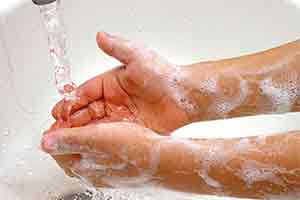Antibacterial Soap Exposes Health Workers to High Triclosan Levels
 UCSF-led study finds exposure to hormone disruptor from soap exceeds that from toothpaste
UCSF-led study finds exposure to hormone disruptor from soap exceeds that from toothpaste
Handwashing with antibacterial soap exposes hospital workers to significant and potentially unsafe levels of triclosan, a widely-used chemical currently
under review by the U.S. Food and Drug Administration, according to a study led by researchers from UC San Francisco.
Triclosan, a synthetic antibacterial agent, is found in thousands of consumer products, including soaps, cosmetics, acne creams and some brands of
toothpaste. The FDA is reviewing its safety based on a growing body of research indicating that it can interfere with the action of hormones, potentially
causing developmental problems in fetuses and newborns, among other health concerns.
In the current study, published in the August issue of the Journal of Occupational and Environmental Medicine, researchers analyzed urine samples from
two groups of 38 doctors and nurses – three fourths of them women – at two hospitals, identified as Hospital 1 and Hospital 2. Hospital 1 used an
antibacterial soap containing 0.3 percent triclosan, while Hospital 2 used plain soap and water.
Workers at Hospital 1 had significantly higher levels of triclosan in their urine than workers at Hospital 2.
The scientists also asked the study participants if they used a popular commercial toothpaste containing triclosan. While those who did had higher
triclosan levels than those who did not, the researchers found that washing with antibacterial soap accounted for even higher triclosan levels than did
brushing with the toothpaste.
“Antimicrobial soaps can carry unknown risks, and triclosan is of particular concern,” said co-investigator Paul Blanc, MD, a professor of medicine at
UCSF who holds the Endowed Chair in Occupational and Environmental Medicine. “Our study shows that people absorb this chemical at work and at home,
depending on the products that they use.”
Blanc recommended that “if non-triclosan-containing soaps are available, use the alternative. This is based on the precautionary principle – that is, if
you don’t know for certain that something is unsafe, it’s better to err on the side of caution.”
The same principle “could be applied more generally in this case,” said Blanc. “It should not be up to the individual to inspect every product for
triclosan. Instead, it’s the duty of the FDA to carry out a review of this chemical and, if indicated, get it off the market.”
For people who want to replace antibacterial products in their home with something safer, said Blanc, “just plain soap and water is a pretty good
alternative.”
Source Newsroom: University of California, San Francisco (UCSF)
Citations
Journal of Occupational and Environmental Medicine, Aug-2014

